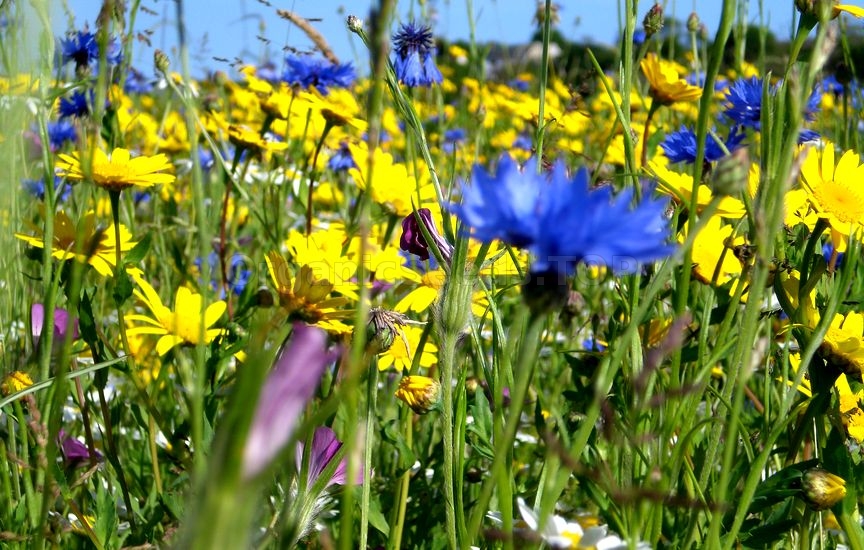Wild Flower Meadows |
 The most attractive way to grow wild flowers is by planting a meadow, although they can be grouped formally in beds and borders to great effect. A quintessential part of the British countryside, wild flower meadows are an important part of our environment and an excellent, wildlife-friendly alternative to lawns and borders. There are two types of meadow you can grow at home - annual meadows and perennial meadows. Both can easily be grown from mixed wild flower seeds or by using wildflower plug plants. Wildflower seeds are the most cost effective option, particularly for annual meadows or for planting up large areas. Where to Grow Wild FlowersAnnual Wild Flowers
Annual wild flowers bloom in their first season, giving a bright show of colour from early summer onwards before dying and setting seed in late summer or autumn. Annual wildflower seeds such as cornflowers, poppies and corn cockle look very effective scattered in beds and borders to create a colourful meadow. Annual meadows such as those seen at the Olympic Park in London aren't strictly wildflower meadows. They contain few grasses and are often a mixture of native and non-native wild flower seeds, such as our Honey Bee Flower Mixed. This creates a very colourful display with big impact and although it's not a true meadow, is still very beneficial to pollinating insects. Unlike perennial meadows, annual wild flowers need rich fertile soil to give the best display.  Perennial Wild Flowers Perennial meadows more truly represent the natural meadows found in the British countryside. Perennial wild flower seeds for meadows consist of grasses and flowers, and thrive best on poor soils where the grass won't outcompete the wild flowers. These meadows are most successful in large areas and take several years to establish properly and flower. Most perennial wild flower mixtures contain a high level of grass seed and are generally unsuitable for small garden use, often turning into a weedy-looking mess after a few years! Perennial wild flowers such as ox-eye daisies, ragged robin and red campion can be found in open areas or woodland. Woodland wildflowers such as primroses, wood anemones and bluebells can be grown from seed or purchased as plants and are excellent for shady gardens. Buy wild primrose seeds here.  Sowing Wild Flower SeedsSow wild flower garden seeds in March and April, or September if your soil is light and well drained. They prefer an open position in full sun. For annual displays, autumn sowing favours wild red poppy seeds and cornflowers, whereas spring sowing tends to favour corncockles and corn marigolds.
Prepare the ground by clearing away all existing plants and grass. It's particularly important to remove vigorous perennial weeds such as stinging nettles, docks and couch grass. In wildlife areas this is best done by hand. Where hand weeding is impractical, a systemic glyphosate-based weed killer may be used, although care should be taken to apply glyphosate on still, windless days. Avoid the use of glyphosate in areas that contain ponds and waterways.  Dig the soil over and firm it well before raking to create a level seed bed. Don't incorporate any fertilisers or manure as this encourages grass growth which crowds out the wild flowers. It's best to allow up to 6 weeks for the soil to settle. This also allows any weed seeds to germinate, which can then be removed with a hoe or weed killer. If your soil is very fertile and you'd like to grow a perennial wild flower meadow you can try stripping away the top 5-10cm (2-4") of soil to reduce fertility. 1g of pure wild flower garden seeds is enough for 1 square metre of soil. Mixed wild flower seeds with grass should be sown at 5g per square metre. Try mixing the seed with silver sand to make sowing easier and more even. Rake the area lightly after sowing and cover with netting to protect from birds and cats. Ensure the soil is kept moist during hot, dry periods for the best germination. Wild Flower Meadow Maintenance Annual wild flowers can be watered while they establish, to encourage good growth. Perennial wildflower meadows should be left to grow naturally without any additional water or fertiliser. Fertile soil favours grass growth which competes with the flowers. Meadows will need cutting back or mowing each year; traditionally they would have been maintained through grazing or hay-making. You can mow paths through wild flower meadows to allow access without trampling the plants. Try and make the path winding rather than straight for a more relaxed feel. This also encourages you to take your time walking along them! You may need:FLOWER SEEDSANNUALSPERENNIALS |
|
|
